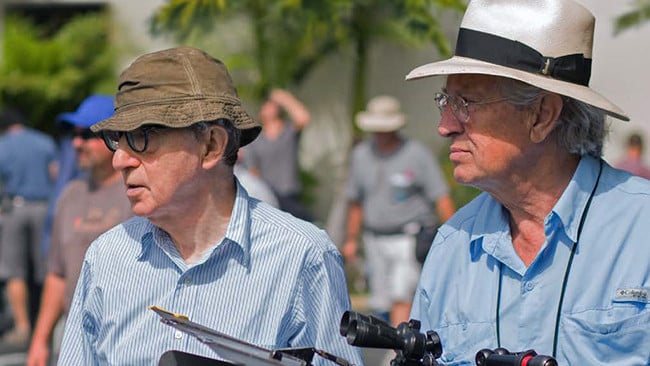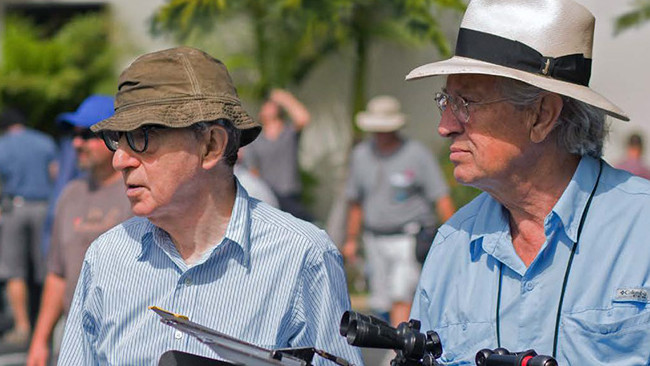
 Woody Allen and Vittorio Storaro on the set of Café Society
Woody Allen and Vittorio Storaro on the set of Café Society
Prior to the first US screening of Woody Allen's Café Society, famed cinematographer Vittorio Storaro detailed how he convinced the director to ditch film for a Sony F65.
As part of this year's Cine Gear, LA's film tech and equipment show that takes over portions of the Paramount lot every June, Sony and Amazon Studios exhibited Woody Allen's latest film, Café Society, in the beautiful Paramount Theater. The picturesque environs perfectly framed the pristine images from the uncompressed, 12-bit 4K DPX projection. However, the press junket with renowned cinematographer Vittorio Storaro (Apocalypse Now, Reds, Last Tango in Paris, The Last Emperor), personally speaking, was the true highlight of the evening.
Prior to the screening, Storaro greeted a small gathering of reporters to answer questions. There weren't a lot of questions asked, as Storaro answered each in great length, but he did expound on camera choice for Café Society. The camera used on Café Society was the Sony F65, marking the first time either Storaro or Allen had ever used a digital camera for a feature production. It was, in fact, Storaro who convinced Allen to eschew film for digital.
Following tech
While the name Storaro has become synonymous with the pinnacle of cinematographic achievement and, yes, those incredible titles of lore were shot on film, Storaro revealed that he "always follows the updating technology." He went on to detail his relationship with digital video, stretching back to 1990s, encompassing early Sony prototype HD cameras, up to present day. He remarked that even three-to-five years ago, the choice between digital and film was difficult and the reasons that people gave for using digital at that time, namely that it was faster and cheaper, were not true. But, recently, options arrived that made digital more attractive for the feature productions.
"Let's be honest. Progress, you can speed up or slow down, but you cannot stop it," said Storaro. He had tested digital by shooting short films throughout the years on early Sony Cine Alta cameras, but it wasn't until he met the Sony F65 that he felt his requirements were met. In particular, Storaro cited the need for 4K 16-bit recording at a 2:1 aspect ratio. That 2:1 ratio is his own proposed Univisium standard, which was inspired by the dimensions of da Vinci's The Last Supper.
Making the argument
At first, Allen was hesitant to take Storaro's suggestion of going digital. Of course, he did acquiesce to his DP's advice, but it wasn't until the second day of shooting that Allen became a convert.
Storaro insisted on two perfectly calibrated monitors, one for him and one for Allen. He received a bit of pushback from the producers concerning Allen's monitor, as the production didn't want to spend money on something the director would not use. Previous to Café Society, Allen would completely ignore the monitors in video village, preferring instead to watch the actors. Storaro implored Allen to watch the monitors, as the images were 80-90% of what the finished film would be. He illustrated this point by showing Allen a jacket an actor wore with a "tonality" he didn't like that clashed with the texture of the actor's shirt. This example drove home the idea that onset monitoring of digital images had gotten so precise that such subtle distinctions could be recognized.
On the second day of shooting, Storaro said that Woody actually asked for his monitor and, from then on, Woody watched each take on that monitor. The director even stopped watching dailies, because, as Storaro put it, "they saw the dailies while they shot."
Café Advice
After the junket, the Paramount Theater auditorium was filled near its 528-person capacity. After a few words from guests and Storaro himself, those in attendance were treated with the first US screening of Café Society. I won't get into Storaro and Allen's visual plan for the film, only to say that when you watch this film, which takes place in Bronx, Hollywood, and New York nightlife of the 1930s, each locale has its own distinct "look," which blend into one another as the film concludes. The images, unto themselves, are wonderfully conceived and executed, but it's in the emotional context of the narrative that the visuals realize their true meaning.
Upon viewing Café Society, I was reminded of something Storaro said in our press gathering concerning the balance between technology and art. "There is a moment in your life that you don't make anymore distinction between your beauty and your pleasure – [it] helps you understand who you are. Through your professional work, you try to get answers to your own questions, the meaning of your life, then anything you do is not an effort any longer, you need to know, you're hungry...one thing I learned, how wonderful it was to be a student...never stop learning."
Tags: Production


Comments